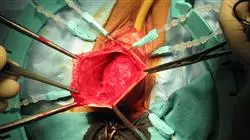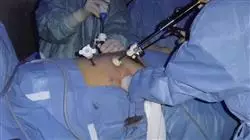University certificate
The world's largest faculty of medicine”
Introduction to the Program
Through this 100% online program, you will handle the most modern urological diagnostic techniques to create personalized intervention plans that optimize patients' overall well-being significantly”

According to a new study conducted by the World Health Organization, Urological Diseases affect more than 250 million people globally. In this sense, the institution foresees that this rate will increase significantly in the coming years due to factors such as the aging of the population, changes in lifestyle or the increase in the prevalence of chronic pathologies. In the face of this reality, practitioners need to stay at the forefront of the latest innovations in the field of urology to improve clinical outcomes and reduce the burden of these conditions.
In this context, TECH has created a pioneering program in Update in Urology. Designed by references in this field, the academic itinerary will delve into issues ranging from the particularities of the molecular biology of cancer or the use of the most modern diagnostic techniques to assess the clinical status of patients to the use of the latest generation of technological tools such as multiparametric magnetic resonance imaging. As a result, graduates will acquire advanced clinical skills to develop personalized treatment plans, lead multidisciplinary teams and apply the latest therapeutic innovations to improve the quality of life of patients.
Regarding the methodology of this program, TECH offers a 100% online educational environment, which allows physicians to combine their studies with the rest of their regular responsibilities. It also employs its unique Relearning system, based on the repetition of key concepts to fix knowledge and facilitate the updating of knowledge. The only requirement is that professionals have a device with Internet access, even their own cell phone.
In this way, they will be able to enter the Virtual Campus to enjoy an educational experience that will elevate their career horizons to a higher level. In addition, the program will include the participation of renowned International Guest Directors, who will give detailed Masterclasses.
Prestigious International Guest Directors will give exclusive Masterclasses that will help you master sophisticated techniques such as reconstructive procedures”
This Advanced master’s degree in Update on Urology contains the most complete and up-to-date scientific program on the market. The most important features of the program include:
- Practical cases presented by experts in Urology
- The graphic, schematic, and practical contents with which they are created, provide scientific and practical information on the disciplines that are essential for professional practice
- Practical exercises where the self-assessment process can be carried out to improve learning
- Its special emphasis on innovative methodologies in urological clinic practice
- Theoretical lessons, questions to the expert, debate forums on controversial topics, and individual reflection assignments
- Content that is accessible from any fixed or portable device with an Internet connection
You will delve into the integration of sophisticated technology such as Focal Therapies, which will help you increase accuracy and adherence to urological treatments”
Its teaching staff includes professionals from the field of Urology, who contribute their work experience to this program, as well as renowned specialists from leading companies and prestigious universities.
The multimedia content, developed with the latest educational technology, will provide the professional with situated and contextual learning, i.e., a simulated environment that will provide an immersive learning experience designed to prepare for real-life situations.
This program is designed around Problem-Based Learning, whereby the student must try to solve the different professional practice situations that arise throughout the program. For this purpose, the professional will be assisted by an innovative interactive video system created by renowned and experienced experts.
Thanks to the Relearning system used by TECH, you will reduce the long hours of study and memorization. You will update your knowledge in a natural way!"

You will design individualized therapeutic strategies for the optimal approach to diseases such as renal carcinoma"
Why study at TECH?
TECH is the world’s largest online university. With an impressive catalog of more than 14,000 university programs available in 11 languages, it is positioned as a leader in employability, with a 99% job placement rate. In addition, it relies on an enormous faculty of more than 6,000 professors of the highest international renown.

Study at the world's largest online university and guarantee your professional success. The future starts at TECH”
The world’s best online university according to FORBES
The prestigious Forbes magazine, specialized in business and finance, has highlighted TECH as “the world's best online university” This is what they have recently stated in an article in their digital edition in which they echo the success story of this institution, “thanks to the academic offer it provides, the selection of its teaching staff, and an innovative learning method aimed at educating the professionals of the future”
A revolutionary study method, a cutting-edge faculty and a practical focus: the key to TECH's success.
The most complete study plans on the university scene
TECH offers the most complete study plans on the university scene, with syllabuses that cover fundamental concepts and, at the same time, the main scientific advances in their specific scientific areas. In addition, these programs are continuously being updated to guarantee students the academic vanguard and the most in-demand professional skills. In this way, the university's qualifications provide its graduates with a significant advantage to propel their careers to success.
TECH offers the most comprehensive and intensive study plans on the current university scene.
A world-class teaching staff
TECH's teaching staff is made up of more than 6,000 professors with the highest international recognition. Professors, researchers and top executives of multinational companies, including Isaiah Covington, performance coach of the Boston Celtics; Magda Romanska, principal investigator at Harvard MetaLAB; Ignacio Wistumba, chairman of the department of translational molecular pathology at MD Anderson Cancer Center; and D.W. Pine, creative director of TIME magazine, among others.
Internationally renowned experts, specialized in different branches of Health, Technology, Communication and Business, form part of the TECH faculty.
A unique learning method
TECH is the first university to use Relearning in all its programs. It is the best online learning methodology, accredited with international teaching quality certifications, provided by prestigious educational agencies. In addition, this disruptive educational model is complemented with the “Case Method”, thereby setting up a unique online teaching strategy. Innovative teaching resources are also implemented, including detailed videos, infographics and interactive summaries.
TECH combines Relearning and the Case Method in all its university programs to guarantee excellent theoretical and practical learning, studying whenever and wherever you want.
The world's largest online university
TECH is the world’s largest online university. We are the largest educational institution, with the best and widest online educational catalog, one hundred percent online and covering the vast majority of areas of knowledge. We offer a large selection of our own degrees and accredited online undergraduate and postgraduate degrees. In total, more than 14,000 university degrees, in eleven different languages, make us the largest educational largest in the world.
TECH has the world's most extensive catalog of academic and official programs, available in more than 11 languages.
Google Premier Partner
The American technology giant has awarded TECH the Google Google Premier Partner badge. This award, which is only available to 3% of the world's companies, highlights the efficient, flexible and tailored experience that this university provides to students. The recognition as a Google Premier Partner not only accredits the maximum rigor, performance and investment in TECH's digital infrastructures, but also places this university as one of the world's leading technology companies.
Google has positioned TECH in the top 3% of the world's most important technology companies by awarding it its Google Premier Partner badge.
The official online university of the NBA
TECH is the official online university of the NBA. Thanks to our agreement with the biggest league in basketball, we offer our students exclusive university programs, as well as a wide variety of educational resources focused on the business of the league and other areas of the sports industry. Each program is made up of a uniquely designed syllabus and features exceptional guest hosts: professionals with a distinguished sports background who will offer their expertise on the most relevant topics.
TECH has been selected by the NBA, the world's top basketball league, as its official online university.
The top-rated university by its students
Students have positioned TECH as the world's top-rated university on the main review websites, with a highest rating of 4.9 out of 5, obtained from more than 1,000 reviews. These results consolidate TECH as the benchmark university institution at an international level, reflecting the excellence and positive impact of its educational model.” reflecting the excellence and positive impact of its educational model.”
TECH is the world’s top-rated university by its students.
Leaders in employability
TECH has managed to become the leading university in employability. 99% of its students obtain jobs in the academic field they have studied, within one year of completing any of the university's programs. A similar number achieve immediate career enhancement. All this thanks to a study methodology that bases its effectiveness on the acquisition of practical skills, which are absolutely necessary for professional development.
99% of TECH graduates find a job within a year of completing their studies.
Advanced Master's Degree in Update on Urology
Thanks to the evolution of scientific research in recent decades, the field of urology has been able to develop various methods to address all types of pathologies related to the urinary system and genitalia of people. In order to perform adequately and provide high quality results in the prevention, diagnosis and treatment of urinary diseases, it is necessary that medical professionals are prepared by applying the latest surgical techniques and procedures. For this reason, at TECH Global University we developed the Advanced Master’s Degree in Update on Urology, a program aimed at addressing the most relevant aspects of this medical area to improve your skills and lead you to stand out as an expert through excellence, enhancing the growth of your career.
Specialize in the largest Medical School
With this Advanced Master's Degree you will expand your knowledge and technical skills in the most innovative developments in the medical-surgical field of urology. With the theoretical and practical study of real clinical cases, you will learn the basic principles of diagnosis, treatment and monitoring of the different conditions that can affect the state of the genital apparatus, you will correctly apply the different tools and therapeutic options depending on the patient's condition, in addition to treating the genitourinary functional sequelae of urological interventions. In TECH Global University we have the largest School of Medicine and a complete and updated scientific program that will help you to manage, from the most common diseases in consultation, to the pathologies that require a more specialized treatment. If you want to guarantee a comprehensive and high quality service in the practice of this discipline, this program is the right one for you.







